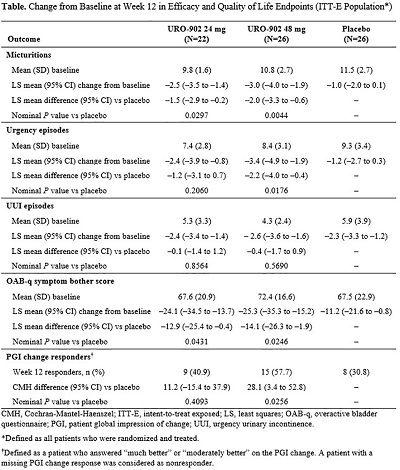Hypothesis / aims of study
There is a need for new agents that can effectively and safely treat overactive bladder (OAB) syndrome when oral pharmacologic therapy is insufficient. URO-902 is an investigational gene therapy for OAB and consists of a plasmid vector that expresses the α subunit of the large-conductance Ca2+-activated K+ channel in the detrusor to reduce bladder hypercontractility. A previous phase 1b trial in patients with OAB showed promising safety and efficacy results for URO-902 [1]. We report interim results from a phase 2a trial assessing the safety and efficacy of URO 902 in OAB.
Study design, materials and methods
This was a prespecified, 12-week interim analysis of a 48-week multicenter, randomized, double-blind, placebo-controlled, dose-escalation study (NCT04211831). The study protocol was approved by institutional review boards at each study center, and all participants provided written informed consent. Women aged 40–79 years with OAB and urgency urinary incontinence (UUI) who were not adequately managed with oral OAB medications were randomly assigned to receive single-dose URO-902 24 mg, URO-902 48 mg, or placebo administered by intradetrusor injection via cystoscopy under local anesthesia. Safety was assessed by adverse events (AEs) and postvoid residual (PVR) urine. Exploratory endpoints included change from baseline to week 12 in mean daily micturitions, urgency episodes, UUI episodes, and quality of life (QoL) measures. This trial had no formal statistical primary endpoint hypothesis and was not powered to detect statistically significant differences between groups in efficacy measures; 23 evaluable patients in each treatment would provide approximately 55% power to detect a between-group difference of 1.8 episodes in the mean change from baseline to week 12 in the number of UUI episodes per day between the URO-902 and placebo treatment groups.
Results
Of the 80 patients randomized, 68 completed week 12, and 74 were included in the intent-to-treat exposed (ITT-E) population. Mean (SD) age was 64.7 (7.1) years, and 13.5% had prior treatment with onabotulinumtoxinA. At week 12, URO-902 24 and 48 mg were associated with clinically relevant improvement vs placebo in mean daily micturitions (LS mean change from baseline, ‒2.5 and ‒3.0 vs ‒1.0, respectively), urgency episodes (‒2.4 and ‒3.4 vs ‒1.2), UUI episodes (‒2.4 and ‒2.6 vs ‒2.3), OAB questionnaire symptom bother score (‒24.1 and ‒25.3 vs ‒11.2), and proportion of patient global impression of change responders (40.9% and 57.7% vs 30.8%) (Table). Treatment-emergent AEs occurred in 45.5% of patients receiving URO-902 24 mg, 46.2% receiving 48 mg, and 50.0% receiving placebo. The most commonly occurring AE (24 mg/48 mg/placebo) was urinary tract infection (0%/15.4%/3.8%). One patient (48-mg arm) had asymptomatic elevated PVR urine volume at week 2 (resolved spontaneously, did not require catheterization).
Interpretation of results
In this phase 2a trial of women with OAB and UUI, a single dose of URO-902 24 or 48 mg was associated with clinically relevant improvement in efficacy and QoL endpoints and was safe and well tolerated.
Concluding message
The safety and efficacy demonstrated in this interim analysis of a phase 2a trial suggest that expressing the α subunit of the large-conductance Ca2+-activated K+ channel in the detrusor is a promising potential therapy for OAB and warrants further investigation.

References
Rovner E, Chai TC, Jacobs S, et al. Neurourol Urodyn. 2020;39(2):744-753.